St Mary Rotherhithe monuments
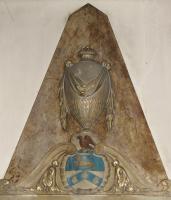
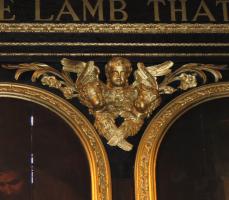
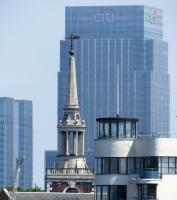
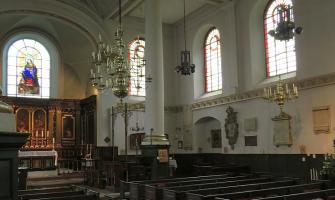

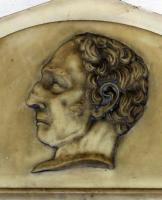
St Mary Rotherhithe, of ancient origin, was rebuilt as a Renaissance style brick building in 1714-15
(and dated thus on the rainwater heads), the architect being John James, with the tower added in the 1730s of 40s
(the date is uncertain despite a stone on the corner inscribed T.T. 1747) by Launcelot Dowbiggin, apparently in a fashion not dissimilar
to his tower at St Mary’s Islington, which I have not seen. The steeple was repaired by George Dance the Younger in 1782, then the spire rebuilt in 1861.
The trees around the Church mean it is this steeple and square tower which is most notable from any distance, and especially
that little spire on top, circular in cross section with little pillars all the way round; it is a distinctive part of the view
from along the riverside.
Inside, the Church was reordered and restored by William Butterfield in 1876, but many of the fittings are 18th Century.
The dark wooden pews and gallery, combined with terra cotta near the chancel and a red and blue carpet down the nave,
give an atmospheric feel to the Church, while the white walls and barrel-shaped, panelled ceiling impart height and light.
Moving to the interest of this website, which is the monuments, there are about 25 monumental panels in all,
a few from the old church on the site, four good ones from the 18th Century, and most of the rest being Victorian.
A feature of the 19th Century panels is for the white inscribed panel to be on a white backing panel
(rather than the more usual black one), with its own supports, again less usual.
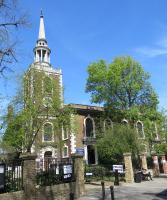
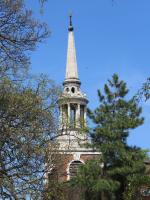
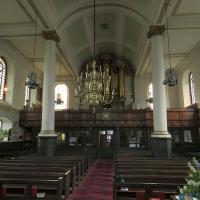
St Mary Rotherhithe, exterior, spire, and interior.
16th and 17th Century monuments:
 Captain Anthony Wood, d.1625.
Captain Anthony Wood, d.1625.
18th Century monuments:
- Joseph Wade, d.1740, and wife Christian (Stephenson), and offspring Jane Jackson, d.1737, Joseph Wade, d.1740,
and Samuel Wade, d.1743, who had erected the monument. Joseph Wade was ‘for many years KING’s Carver
In his Majesty’s Yards at Deptford and Woolwich. In which Profession he was Equall’d by Few And Exceeded by None’.
This is a splendid cartouche, thus with a violin-shaped centre bearing the inscription, surrounded by an ornate, broad border
of carving. Often in such monuments the surround is a mix of scrolling and drapery and Acanthus leaves,
but here it is almost entirely leaves, rather seeweedy at the top, with pomegranates and flowers lower down.
A winged cherub head is on one side, a winged skull on the other, emblem of mortality, and a plump, naked cherub sits on top,
with jowly face and fat little limbs; he holds in one hand a small oval panel bearing a relief portrait of the deceased,
wearing a loose cap and shirt (to appreciate this, you will need to click on the picture below to enlarge). The carving overall is excellent, with numerous cut-throughs to increase the delicacy of the piece,
and various details including a bird and a fish.
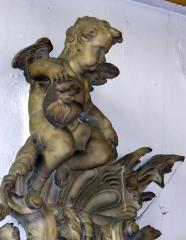
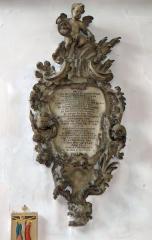
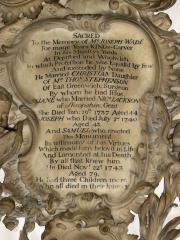
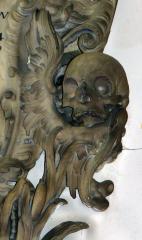
Joseph Wade, d.1740; cartouche monument, and details.
- Alexander Roberts, d.1758, Martha Roberts, d.1763, and her husband Michael Roberts, d.1768.
Panel with a flamboyant surround of scrolls, flowers and fruits. At the top, a cartouche with painted arms,
and at the base, a winged cherub head with two small drapes hanging from behind the head and over the ends of the outstretched wings,
rather unusual. Indeed, the free style of this monument, with the carving to the sides unencumbered by any backing or outer border,
is rather uncommon, and most successful, bearing comparison with the Joseph Wade cartouche noted above.
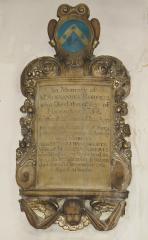
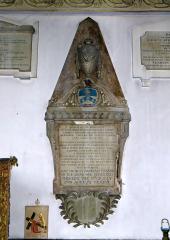 Alexander Roberts and Elizabeth Barrow, later 18th Century panels.
Alexander Roberts and Elizabeth Barrow, later 18th Century panels.
- Elizabeth Barrow, d.1775, erected by her husband, Captain Thomas Barrow, d.1789.
An obelisk monument, thus divided into an upper portion, bearing the obelisk or tall pyramid, and below a central shelf,
the lower portion, bearing the inscription. Here, the upper obelisk, in a fine light and dark brown marble,
bears upon it an egg-shaped pot or funereal urn, with a thin stem and delicate draperies festooned across it
and hanging to either side. On the lower portion of the body there are gilt leaves. The pot stands upon a sort of
swan-necked pediment, bearing a shield of arms, painted, and thicker gilt leaves. Beneath the central shelf is a line of waves
in low relief, and then the inscription, framed in a similar marble to the obelisk, and with side pieces.
At the base, less usually on such monuments, is a broad oval with two ferny branches tied together surrounding it,
light and feathery – once there would likely have been a painted shield of arms in the centre.
A most fine monument of its time. I rather doubt that the gilding on this piece, and on several other monuments,
is original, but it is sparingly applied and in inspired good taste.
- Prince Lee Boo, d.1784 – the commemorative panel inside the Church is of later date;
see the list of 19th Century monuments below.
- Mrs Martha Davis, d.1797, with a nicely cut inscription with a Biblical quote in flowing script.
The central panel has side pilasters with inset black fluting, and above, instead of a normal pediment,
there is a cut out shape of marble in a cloudlike series of curves. There is a simple apron at the base,
and two supporting brackets with mouldings. The use of different coloured marbles more or less died out in 1800
when foreign supplies dried up, so this is a late example of the type.
19th Century monuments:
- William Roberts, d.1815, a merchant, and his wife Ann Roberts, d.1848. Tall panel cut to pediment shape
at the top, bearing a small carved wreath with ribbons, and a thick base with mouldings, and supported on two carved leafy brackets.
All this on a white backing panel with its own brackets, and signed by the stonemason, Kelsey. There was a Kelsey of Brompton,
known by a couple of tablets in Bedfordshire, and the better-known sculptor C.S. Kelsey, who made the decorations for
Smithfield Market, but the latter was born in 1820, so this would be a bit early for him.
- William Coleman, d.1820, panel with side pilasters, thin top and bottom shelves, and above,
without an entablature, a curved pediment with curvy side pieces above the pilasters; at the base, small feet (see picture further down this page).
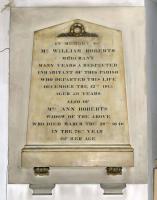
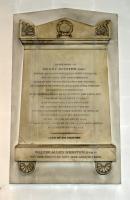 Roberts and Meriton monuments, early 19th C, vertical format.
Roberts and Meriton monuments, early 19th C, vertical format.
- Henry Meriton, d.1827, who ‘served the Honourable East India Company in various appointments with distinguished zeal,
activity and fidelity’, and added later, his brother Walter Allen Meriton, d.1853.
A tall panel with blocky upper part cut to a pediment shape, with mouldings, acroteria carved with anemone,
and a central wreath in relief. At the base, a blocky shelf with half-round supporting brackets incised with simple
leaflets or petals. On a shaped white backing. A very characteristic shape of panel from these times,
somewhat more substantial than the landscape ones.
- Harriet Stephenson Simson, d.1827, and infant son Charles Carter Simson, d.1827,
panel with nipped corners on white backing with blocky feet.
- Barmby family, from Mrs Martha Elizabeth Barmby, d.1837, through to John Barmby, d.1887(?).
Tomb chest end with upper lid bearing a wreath, and with a shaped backing bearing acroteria (‘ears’) at the sides.
- Soper family, or more correctly ‘the late united family’ of William Soper d.1839,
and his wife Elizabeth Soper, d.1839. 16 members of the family are listed, mostly dying as children,
with the last two added names on the panel deceased in 1841.The text is crammed in to fit it all on the panel,
in the fashion of panels of a century or so previously. At the top, above a thin shelf, the marble is cut to the shape
of a curved pediment, enclosing a relief portrait of a man in profile, whom we must presume to be William Soper.
He is shown with short, curly hair, and bony features, including a Roman nose, large ear, and strong angle to the chin,
depicting sternness rather than any form of ideal portrait. The base is cut with central triangle and side pieces,
like an upside-down pediment, and the whole is on a white backing with a pointed top (see picture below left, and portrait at
top of page, far right).
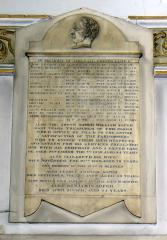
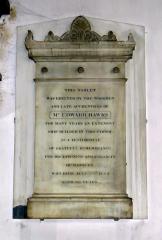
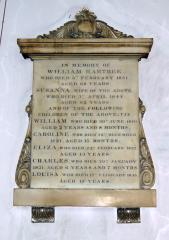
Decorated mid-19th Century panels; that on the right is by Kelsey.
- Robert Speck, d.1839, his wife Sarah Speck, d.1859, and Mrs Ann Leggett, d.1840.
Panel with upper shelf above which is a simple rimless pediment enclosing a carved wreath with small ribbons.
The backing panel is cut to shape and has two small supports (see picture a little way down the page).
- Edward Hawks, d.1844, a local ship builder, ‘erected by [his] workmen and late apprentices’,
a tall panel with correct proportions, with a thin upper shelf, a space acting as entablature bearing three button-like flowers,
then a thicker shelf with mouldings bearing an ornamental carving of stylised vegetation in high relief, loosely pediment shaped, with acroteria.
There is a thick base and the usual white backing panel (see picture, above centre).
- Thomas Smith, d.1848, put up by subscription of members of the Royal Thames Yacht Club,
‘of which society he was from its formation a strenuous supporter’. Panel with upper and lower shelves,
the upper one being decorated with repeating ball carving, and supported by brackets resting on corbels
carved with simple flowers. The whole thing is on a rectangular backing with its own supports.
The minor decorative features are gilt, if gilt it is, in a dull, silvery-gold colour – this is a feature
of the two panels in the Church signed by Kelsey, perhaps indicating this is another panel by the same mason or company of masons.
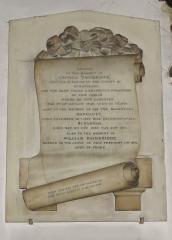 Scroll panel to George Bainbridge, d.1848.
Scroll panel to George Bainbridge, d.1848.
- George Bainbridge, d.1848, daughters Margaret, d.1822, and Susannah, d.1826,
both infants who died soon after birth, and nephew William Bainbridge, d.1841. The panel is carved as a hanging scroll,
wound up at the top, and unrolling asymmetrically over a partly-concealed ledge behind.
Such panels are widespread but never common, and take a variety of forms – this one is at the more ornate end of the scale –
and formed a visually arresting alternative to the conventional panel monument in the early and middle 19th Century.
Above the scroll is a nicely carved ribbon, winding around the cord holding the scroll. The whole is on a white backing panel,
on which there looks to be a very worn signature of the sculptor, but I could not make it out.
- Everilda Bracken, d.1849, assisting cholera victims in the Parish. Plain panel with nipped corners
on similarly shaped backing with block supports.
- William Hartree, d.1851, wife Susanna Hartree, d.1844,
and five offspring all of who pre-deceased their parents. With upper and lower shelf, and on top,
a pedimental shape made out of a central cartouche surrounded with droopy Acanthus leaves. At the base are two carved brackets,
and to the sides of the main panel are scrolly ornaments reaching half way up (see picture a little way up, right). A decent work, by Kelsey, who we met as carver
of the more humble William Roberts panel. The gap of 35 years between the two monuments suggests this may have been a family firm
with the son taking over from the father.
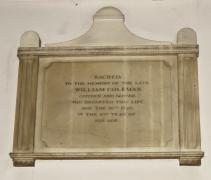
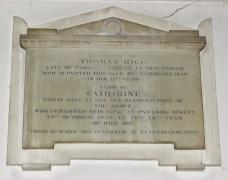
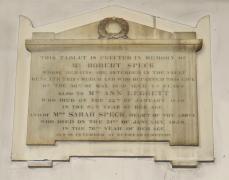
Horizontal panels, 19th Century: Coleman, Rigg, Speck.
- Ann Davies, d.1852, daughter of James Ford, Corn Merchant, and who died of yellow fever at Bahia, South America.
Horizontal panel with shelf part way up, and above that, a tiny central shield carved in relief with a tree,
fallen female figure and a dog standing on her body; the top of this vaguely heraldic design has a further tree perhaps
with a lamb under it. On a white backing panel with block feet. This humble piece is signed by
Thomas Gaffin of Regent Street, most prolific of monument makers of the early 19th Century.
- Thomas Stokes, d.1856, another panel with nipped corners on a shaped white backing, itself with nipped lower corners,
and two thin block supports.
- Thomas Rigg, d.1858, and wife Catharine, d.1853, another tomb chest end,
cut with feet, and with upper shelf and pedimental top with wreath, and backing with side acroteria (see picture above, centre). As per the Barnby monument.
- Prince Lee Boo, d.1784, ‘son of Abba Thulle, Rupack or King of the Island Coorooraa,
one of the Pelew or Palos Islands’, put up in 1892 by the Secretary of State for India, to commemorate
‘the humane treatment shewn by the natives to the crew of the Honourable East India Company’s ship
‘Antelope’ which was wrecked off the Island of Coorooraa in 1783’. The unfortunate prince was invited back to England, but did not survive long.
The central panel is black with gilt inscription in small,
close-set capitals, which is characteristic of 17th Century monuments, but the surround is typical of the 1890s,
being in pink and brown veined alabaster, with a pediment enclosing a cross within a circle, and carved festoons at the base.
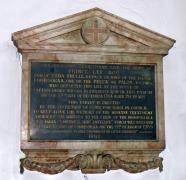 Prince Lee Boo's commemorative panel.
Prince Lee Boo's commemorative panel.
20th Century panels:
- Revd. Ronald Wimbush, d.1964, Chaplain, a red Shap granite panel with gilt lettering.
- Stacey Lynn Kavanagh, d.1985, a child, plain panel with reddish- coloured lettering.
Brass:
We note one ancient brass with a picture:
- Peter Hills, d.1614, ‘Mariner, one of the eldest Brothers and Assistants of the Company
of the Trinity' (and his two wives), with a separate panel noting that the panel was ‘made at the charge of R[ober]t Bell:
Though Hills be deade, Hill’s will and Act survi[v]es, // his Fre Schole and his pension for the poore // Thought on by him,
partformed by his heire,// for eight poore seamens children and noe more.’ Above the two inscribed panels is a much worn panel
depicting Peter Hills and his two unnamed wives. He stands in the centre, arms across his breast and the worn away hands
I think raised in prayer; his wives stand in similar postures to left and right, facing a little inwards, so the trio form
a harmonious composition. The wives wear hats and wide ruffs above broad-shouldered shirts and long skirts; Hills himself
wears a plainer robe down to the feet.
Also in the Church:
- An oil painting of Charles IV disappeared in the 1990s and has been replaced by a copy.
- Another oil painting showing Christ wearing the Crown of Thorns, gazing upwards.
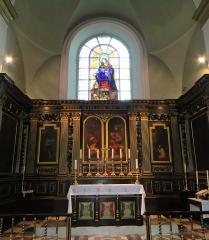
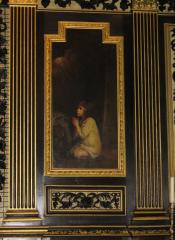
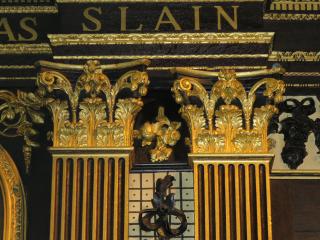
The Reredos, and details.
- The Reredos, really rather grand, a great piece of panelled woodwork, divided by gilt
Corinthian pilasters, and containing oil paintings of religious figure subjects. According to information in the Church, Joseph Wade,
whose memorial is noted above, carved it, and the paintings, copies of older works, were emplaced in 1925.
- The altar table has on its front three square panels with nicely painted angels, as youths with
double-wings. Of Butterfield’s time I would guess.
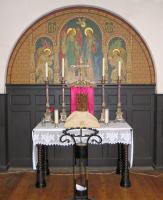
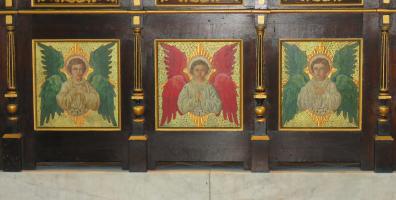
Wall painting and altar, Butterfield's work I think.
- Wall painting, presumably also from Butterfield’s time, showing the Annunciation with small angels to the sides of the semicircular,
triptych design.
- The font, wooden, of the thin, round variety and carved with winged cherub heads.
- Ornately carved wooden lectern, a mix of historic and more modern work.
- Wooden pulpit, hexagonal, apparently cut down from a three-decker one erected in the early 19th Century.
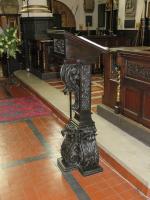

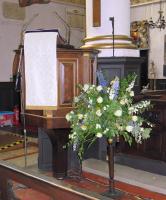
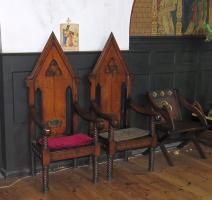
Wooden furnishings in the Church, and chairs made from the Temeraire.
- Metal screen, with fancy ironwork.
- Grand organ, 18th Century, rising all the way to the ceiling, and with busty angels blowing trumpets
at the top – gilt, doubtless wooden too. There are other similar things in a few of the City Churches. Lower down on the organ
are panels with musical instruments, and winged cherub heads.
- Two high-backed wooden chairs made from wood from the ship Temeraire, which famously fought
in the battle of Trafalgar, was painted by Turner, and was broken up at Rotherhithe in 1838.
- A wooden ship model up on the gallery.
- A modernish wooden triple-panel rendering of the Adoration of the Shepherds. In traditional style,
but it needs a century or so to darken down to the prevalent colour of the older wood in the Church.
- Royal arms, much painted and gilt, and carved with many flourishes, which information in the Church
says was made in the time of Charles II.
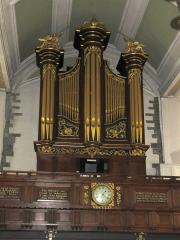
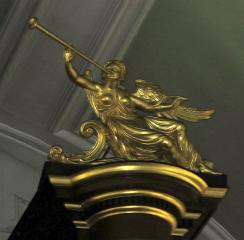
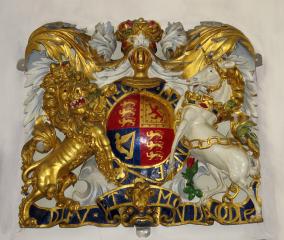
More woodwork: organ, one of the angels, and the Coat of Arms.
Outside:
There is a small churchyard around the Church, including Prince Lee Boo’s monument,
the burial ground across the street having been relaid out as a public garden. There is a Georgian house next to the Rectory
with painted statues of Charity Children, a boy and a girl – this is the premises of the Amicable Society’s school
founded by Peter Hills in 1613, noted above.
With thanks to Fr Mark Nicholls for permission to show pictures of the monuments inside; the Church website is at
http://www.stmaryrotherhithe.org/index.php?option=com_content&view=article&id=7&Itemid=9.
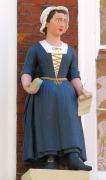
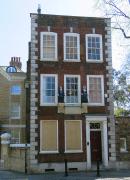
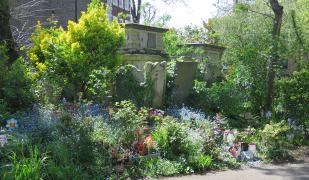
Amicable Society with charity children, and the churchyard.
Top of page
West to St Mary Bermondsey // or Bermondsey Town Hall // South via Lower Road through to St Nicholas Deptford // and St Paul Deptford
Go South West to the Caryatids in Southwark Park
Other London Churches // London sculpture // Introduction to church monuments
Angel statues // Cherub sculpture
Home
Visits to this page from 12 June 2015: 7,548










 Alexander Roberts and Elizabeth Barrow, later 18th Century panels.
Alexander Roberts and Elizabeth Barrow, later 18th Century panels.

 Roberts and Meriton monuments, early 19th C, vertical format.
Roberts and Meriton monuments, early 19th C, vertical format.



 Prince Lee Boo's commemorative panel.
Prince Lee Boo's commemorative panel.









